If you’re a conscious gardener, then you know just how important native flowers can be to your local ecosystems. Learning how to grow wildflowers in your backyard isn’t too difficult of a task. Actually, it’s quite easy since wildflowers are acclimated to your area, unlike foreign plants that will need to adapt.
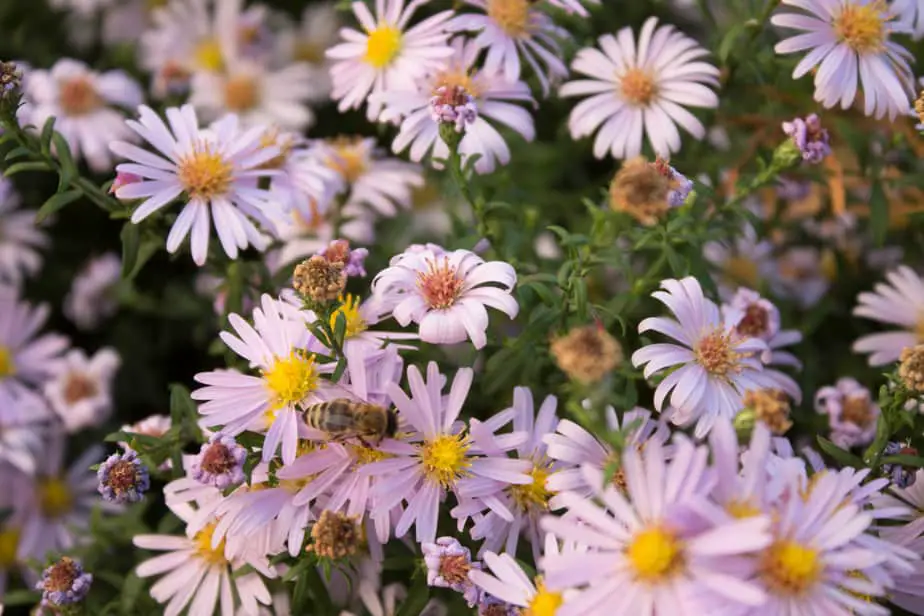
In this article, we’ll go over everything you need to know to grow gorgeous wildflowers in your backyard. This includes which types of flowers you should be planting where you live and how to care for them, along with a few wildflower garden ideas to get you started.
It’s time to get our hands dirty!
Table of Contents
Wildflowers Native to Your Region and Planting Time
When learning how to grow wildflowers in your backyard, the first thing you need to determine is what flowers are native to your area.
You can do this be researching wildflowers commonly found in your state on the US Wildflowers Website or by using the Region Wildflower Finder from AmericanMeadows.com. You’ll also need to make sure that you understand prime planting time for wildflowers.
If you’re in the Northern, cooler regions of the United States, you’ll want to plant your wildflowers after all snow and frost have passed. Cold temperatures can kill seedlings, so be sure all cold temperatures have gone. If you’re unsure of when frosting usually ceases in your area, you can refer to this handy Frost Dates Chart.
If you’re in the Southern, warmer region of the United States, you’ll want to plant your wildflowers in the early spring. With no danger of lingering frost or dropping (or high and intense) temperatures, your seedlings should have a fair chance at sprouting when planted at this time. The further south you are, the more likely you’ll need to find drought-resistant wildflower seeds.
Or, if you already know what wildflowers are common near you and when to plant them, you can skip this step and get straight to preparing your land for planting.
Finding a Place for Your Wildflower Seeds
Wildflowers are extremely adaptable to a soil that would otherwise be poor for more delicate plants or plants that aren’t native to your area. For wildflowers, the only real requirements are that you plant the seeds in an area that gets full sun (or 6 or more hours of sun each day). You’ll also want to be sure that the area of land you choose doesn’t flood or hold water for long after a rain.
There are a few wildflower seed mixes that are fine for partial shade, but just to be on the safe side, it’s best to plant in full sun. A good way to see if the area you want your wildflowers to grow in is good for planting is to look for any type of weed growth. If weeds can grow easily on that patch of land, wildflowers should do just fine.
Preparing the Land for Planting
As with all flora, there is competition for sunlight. To ensure that your wildflower seeds will germinate and grow into beautiful flowers, you’ll need to remove any existing competition in their field. If there are any weeds, thick grasses, bushes, viny plants, etc that could possibly steal the light from your wildflowers, remove them by hand – down to the root – or use a weeding tool for a more complete job.
Alternatively, you can use a rototiller to remove unwanted plants if you’re covering a large field. Be sure to remove any plant competition from the field or garden area a week or so before sowing your wildflower seeds. If you plan to plant your seeds in a few months (say around 3-6), you can make use of synthetic herbicides or environmentally friendly weed killers. By the time you plant, all chemical residue should be gone.
Planting Your Wildflower Seeds
Before you plant your seeds, you’ll want to be sure of three things: that the soil is warm enough, that you’re planting at the right time of day, and a watering schedule. Let’s briefly go over each individually:
Soil Temperature
We’ve already discussed that you’ll want to wait to plant your wildflower seeds in your backyard after any signs of frost or cold weather have already passed. But keep in mind that just because the air has warmed, doesn’t necessarily mean that the soil isn’t still too cool for germination.
You can easily determine the temperature of your soil by using a soil test kit, or by utilizing this online Soil Temperature Resource.
The Right Time of Day for Planting
Though not always applicable to regions further up North, down south it may be ideal to plant and water your seeds in the evening, near dark. This is because the sun will not have time to quickly evaporate the moisture from the seedbed, allowing your seeds to receive the proper moisture level.
This is especially so for those who can not tend to their seeds during the day when the weather is hotter.
Laying Seed
When you go to lay your seeds, be sure to distribute them as evenly as possible over your plot of land or garden bed. Do not pack the seeds densely, as this could create more competition that you don’t want. A nice and even spread is more likely to yield colorful results than thousands of seeds piled up in one place.
Press your seeds into the soil using your foot as you plant along. You can also use wooden boards or plywood to lay over the seeds and walk over, pushing them deep into the dirt.
Watering
Seeds and seedlings should be kept moist (though not waterlogged – remember, proper drainage is essential to wildflower growth) until they are grown to about 6 inches tall. You can use a sprinkling system to keep them well-watered or water them by hand if you’ve planted the wildflowers in a small garden. Again, try to water when the sun isn’t at its hottest as to avoid immediate evaporation and drying out.
Maintainance
To keep your wildflower field or garden in tip-top shape, occasionally weed out any competition plants or grasses. You’ll also want to remove any dead or dying blooms from flowers to encourage better growth and budding.
As counterintuitive as it may sound, you can mow your wildflower field at the end of the blooming season and after they’ve dropped their seeds. This will keep your yard from looking scraggly when late fall and winter rolls around.
Wildflower Garden Inspiration
1. Sea of Color
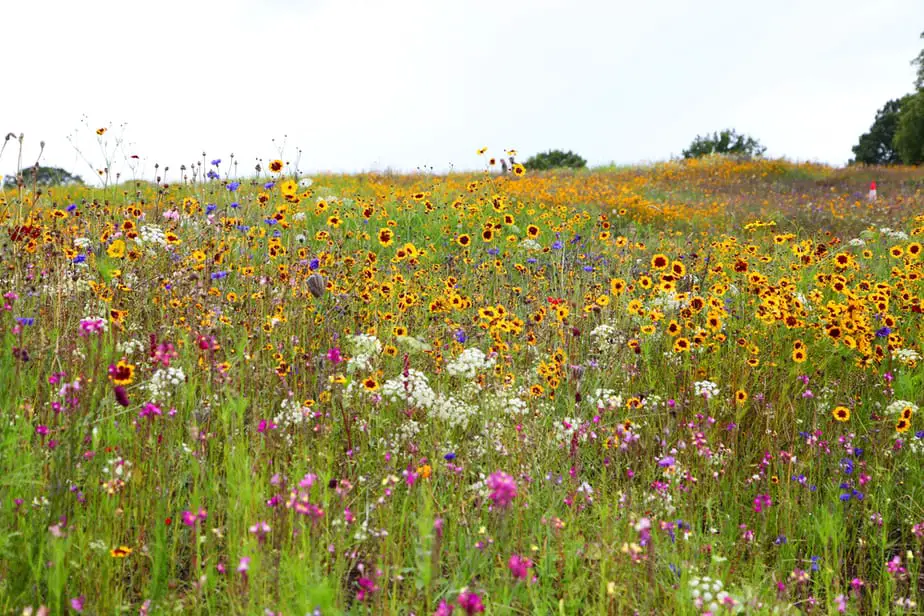
If you have a large field or even acres to work with, planting a variety of wildflower seeds could result in a gorgeous array of colors, textures, and shapes. While a single species of wildflower would absolutely be awe-inspiring, we feel a sea of brilliant colors does wonders for adding intrigue to any garden or property.
2. Wildflower Edging
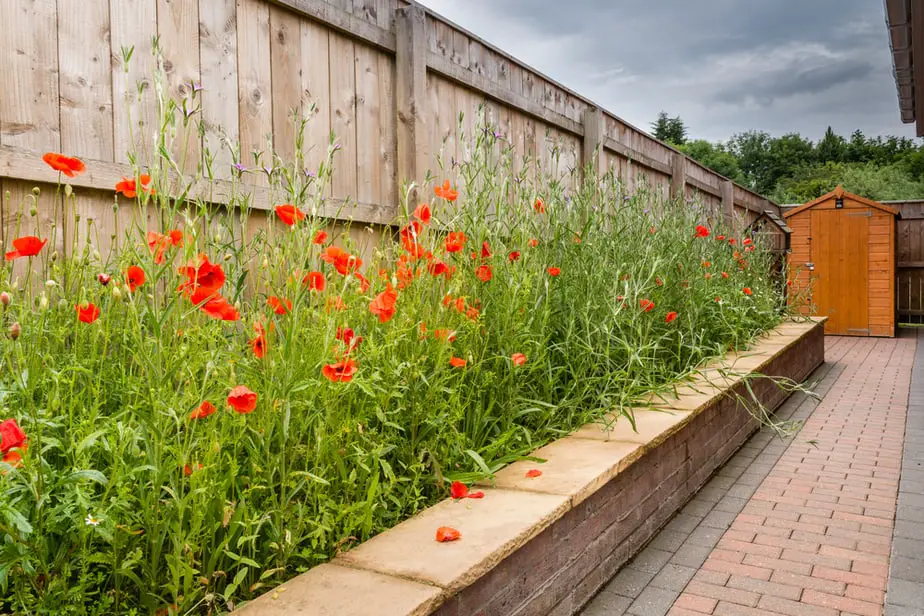
For those who don’t have much space to work with, or would rather keep their wildflower garden contained, this edging made of stone and wild Poppies would make a stunning addition to any patio or walkway. This is the ideal way to bring nature and a splash of color to a tight-knit, fenced-in neighborhood home.
3. Rustic Setting
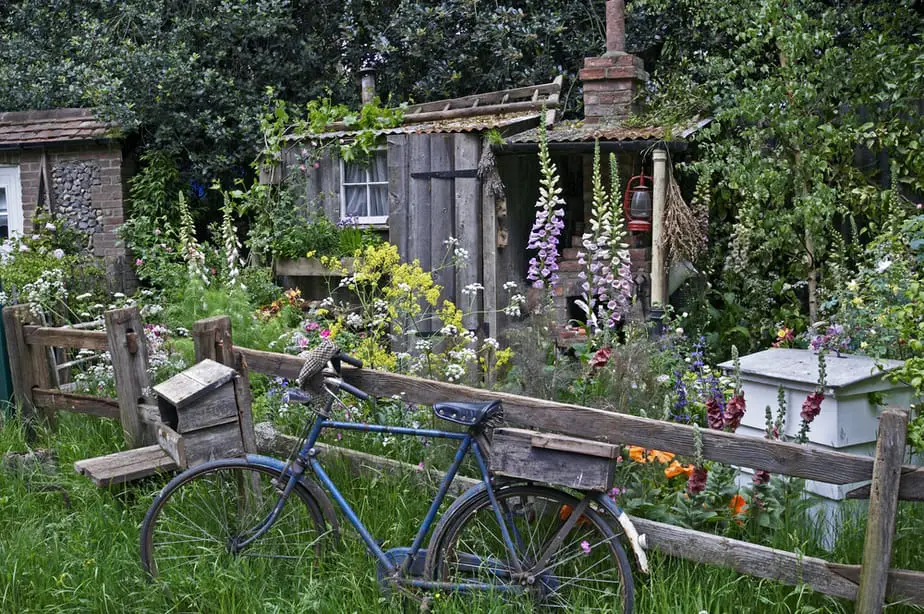
A rustic home just isn’t complete without wooden buildings, fences, and a vast volume of wildflowers growing every which way. For a more natural appearance, you may want to select a mixed variety of wildflower seeds. This would give your outdoor space a more holistic feel that would surely bring each of your garden guests to ease of mind.
4. Lining the Pathway
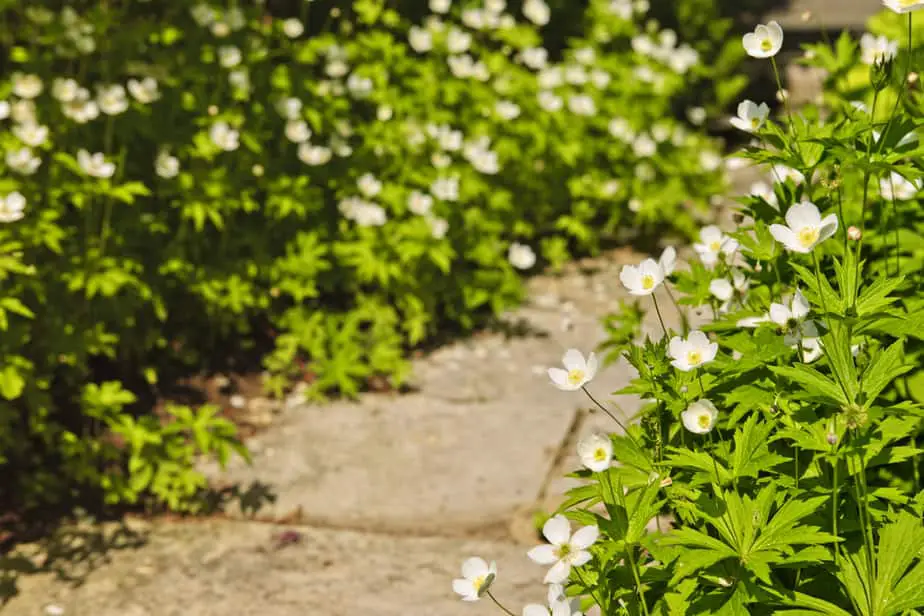
To make your home look less concrete, consider lining your home walkways with wildflowers. A sidewalk overflowing with lovely blooms would make an otherwise average walk to the front door a leisurely stroll through a serene garden; filled with soothing scents and eye-catching color schemes.
Final Thoughts
Unlike other types of gardening that may require you to babysit your plants, learning how to plant wildflowers in your backyard is nothing less than a breeze. Before you begin planting, educate yourself about the wildflowers in your area, which ones you’d like to plant at your home, and how often they should be kept. Find an area that is exposed to the sunlight at least 6 hours a day and ensure that your seeds get enough moisture throughout the day to germinate.
Continue to remove any weeds or competition plants that may disrupt the growth or success of your wildflower field or garden and double-check that you’re planting on land that is able to drain water well. Keep the time of year in mind and the temperature of the air and soil before you begin planting.
After all the work is done, sit back and enjoy the breathtaking blooms. We hope we were able to provide you with the most comprehensible insight into wildflower planting! Gardening is a joyous hobby for millions of homeowners all over the world that not only leads to pride in your home, but to a heart fulfilled with the beauty of the end results.
Happy gardening!